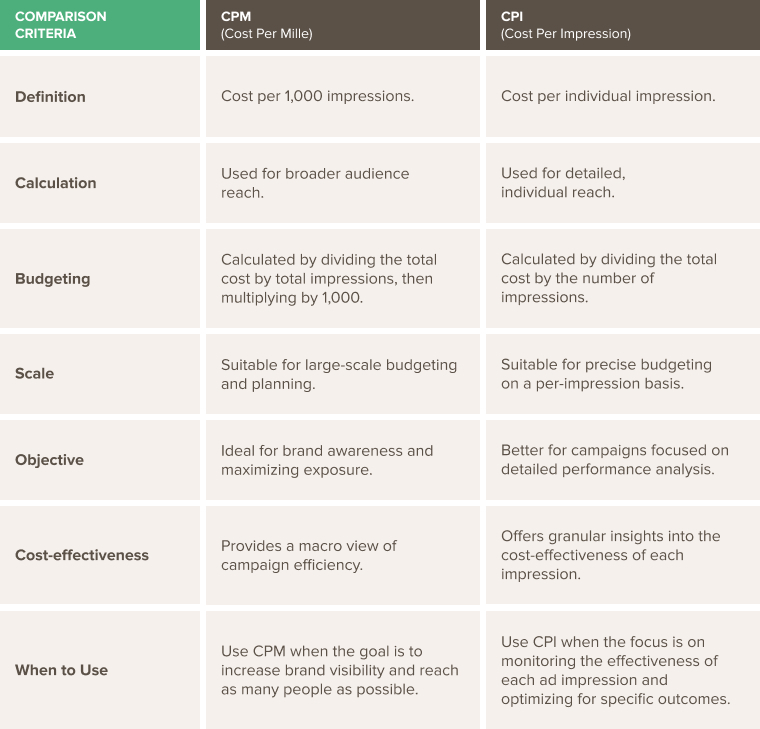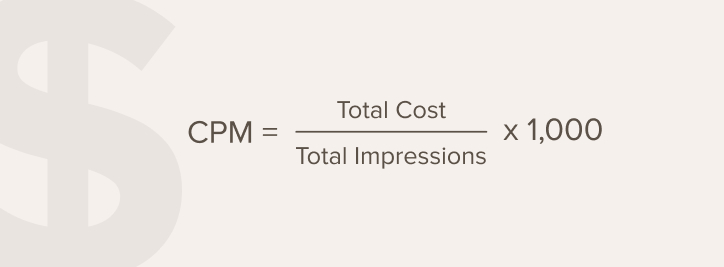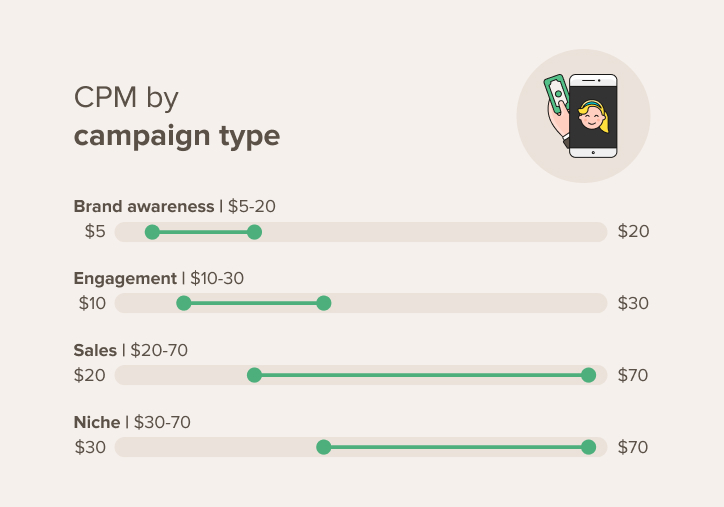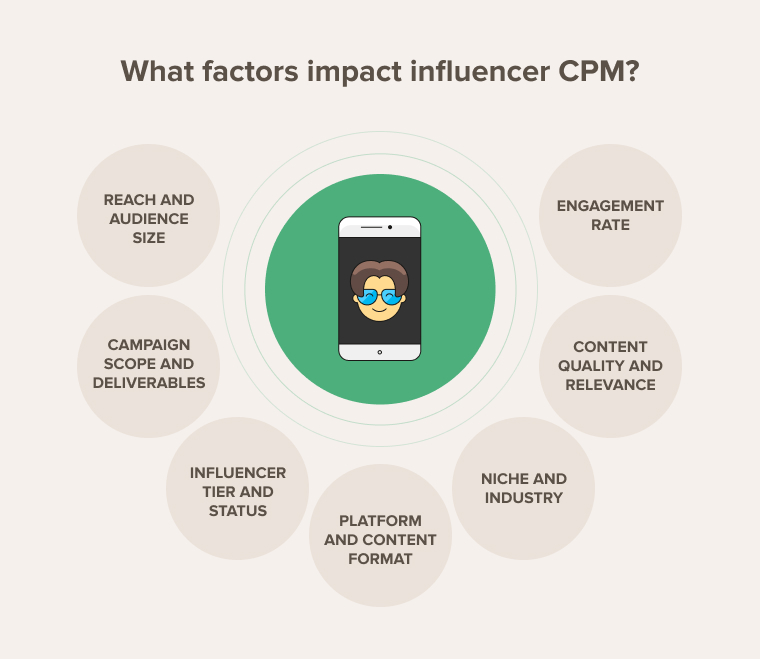Free Influencer Marketing Series
Success! Enjoy the series! Part 1: How an agency took a brand from 0 to $1MM in 4 months using influencers & ads
Free Influencer Marketing Series
Success! Enjoy the series! Part 1: How an agency took a brand from 0 to $1MM in 4 months using influencers & ads

Every influencer marketing campaign is different, which is why it’s important to monitor a specific set of metrics to see what’s working and whether you’re getting a good return on investment (ROI).
CPM (or Cost Per Mille) highlights how much you’re paying per 1,000 impressions (or followers or video views) which can help you manage your budget and ensure you’re not overpaying to get the reach you want.
In this article, we'll explain what CPM is and how to calculate it, as well as recap optimal CPM ranges for different types of influencer campaigns.
Influencer marketing CPM stands for Cost Per Mille, with "mille" being Latin for "thousand."
It's a metric that helps you understand how much you pay an influencer for every 1,000 impressions (an impression being a singular “view”).
Let's say you launch an influencer marketing campaign with an influencer who charges a CPM of $50. For every 1,000 people who see the influencer's post on social media, you'll pay $50. If their post reaches 10,000 views, you'll be looking at a total cost of $500.
There’s often confusion between CPM (Cost Per Mille) and CPI (Cost Per Impression), so here’s a quick differentiation.

Here’s a simple formula for you to calculate the CPM of your campaigns.
CPM = (Total Cost / Total Impressions) x 1,000
This equation helps you determine exactly what you’re paying for every 1,000 views or impressions on an influencer's sponsored content.
Let's break down the formula further:
Total Cost is the amount you're paying the influencer for their services, whether it's a flat fee, a commission, or any other agreed-upon compensation.
Total Impressions reflect the number of times someone has seen the influencer's content.
Here are a few examples to understand this better:
Example 1: You agree to pay an influencer $500 for a sponsored post, which ends up reaching 20,000 impressions.
To calculate the CPM, plug the numbers into the formula:
CPM = ($500 / 20,000) x 1,000 = $25
In this case, you're paying $25 for every 1,000 views.
Example 2: An influencer charges a flat rate of $1,000 for a sponsored video. The video garners 50,000 views. Let's calculate the CPM:
CPM = ($1,000 / 50,000) x 1,000 = $20
Here, your CPM is $20, meaning you're paying $20 for every 1,000 views on the video.
This CPM formula gives you a standardized way to compare costs across different influencer partnerships. It helps you evaluate whether an influencer's rates align with your budget and the potential reach they offer.
Keep in mind that while a lower CPM may seem more cost-effective, it's crucial to consider other factors like engagement rates, audience quality, and the influencer's overall fit with your brand.
Some marketers categorize CPMs by whether the audience is targeted or untargeted. Targeted reach is more valuable because you are reaching the people you want. For example, 1 million impressions from 100 micro influencers is a targeted approach vs. 1 million impressions from a billboard which is not targeted reach.

The optimal CPM depends on the type of campaign you’re running and your goals. Here’s a breakdown of what a “good” CPM looks like for different campaigns—but bear in mind that this will depend on your industry, products, target geography, and the influencers you partner with.
The main priority of a brand awareness campaign is to reach a wider audience. In this case, a lower CPM is preferable as long as the campaign reaches the right audience.
Optimal CPM Range: $5 - $20
If you want to generate more engagement and start more conversations, you may pay a higher CPM to ensure you reach the right people who are going to engage with your content.
Optimal CPM Range: $10 - $30.
The CPM of a niche campaign will often be higher than other types of campaigns because you’re trying to reach a limited audience. Niches that are harder to reach will have higher CPMs.
Optimal CPM Range: $30 - $70+
The CPM for conversion-focused campaigns will be higher since the campaign's success is measured in terms of tangible results.
Optimal CPM Range: $20 - $50+

Several factors can impact an influencer’s CPM and, therefore, their overall rates. Here are the most common:
The main factor that affects an influencer’s CPM is their average reach and audience size.
Mega or macro influencers tend to have a higher CPM because of their huge social media audience. They’re exposing your brand to a wider audience which pushes up the average CPM rates—the cost of working with them is higher, so the CPM often trends in that direction too.
For example, you’ll need to have a sizable budget if you want to collaborate with a celebrity influencer.
“Celebrity-driven campaigns naturally command a higher CPM due to their expansive reach and influence,” says Stacey Jones, Founder of Hollywood Branded. “This premium isn't just about the celebrity's star power; it's an investment in their unique ability to amplify a brand's message to a broader and often more engaged audience.
“The challenge here is ensuring the celebrity's fan base aligns with the brand's target market and that their persona reinforces the brand's messaging, transforming a higher financial outlay into a strategic investment with tangible returns in brand visibility and engagement.”
Like Jones suggests, it's not all about follower count—you should also consider the quality and engagement of the audience. An influencer with a smaller but highly engaged and targeted following may be more valuable than one with a massive but unengaged audience.
When evaluating an influencer's reach, look beyond vanity metrics and dig into their audience demographics, engagement rates, and the authenticity of their followers.
While high follower counts and expansive reach are particularly compelling, you shouldn’t rule out engagement rates in determining an influencer's CPM.
Engagement refers to the level of interaction an influencer's content receives, including likes, comments, shares, and saves. Higher engagement rates indicate that an influencer's audience is actively interested and invested in their content. And, when an influencer has higher engagement rates, their sponsored posts are more likely to be seen, interacted with, and trusted by their followers.
As a result, influencers with high engagement rates often command a higher CPM. To assess an influencer's engagement, calculate their average engagement rate by dividing the total engagements by their follower count and multiplying by 100.
TIP: Check for high quality influencer engagement before paying more for higher engagement. Comments to likes ratio is one metric to evaluate. Also, watch for signs of influencer engagement pods. Their artificial engagement does not benefit your brand.
The location of your target audience impacts CPM rates. You'll find higher CPM rates in countries where consumer spending power is greater. And lower CPMs in developing countries.
The quality and relevance of an influencer's content can significantly impact their CPM. Influencers who produce high-quality, visually appealing, and engaging content tend to have higher CPMs.
Why? Because their content is more likely to capture attention, spark interest, and drive action. The bottom line is, influencers who create content that aligns with your brand's values, aesthetic, and target audience are more valuable partners.
When an influencer’s content naturally resonates with your brand, their sponsored posts will feel authentic and be more effective in reaching and influencing your desired audience.
The niche and industry an influencer operates in can also affect their CPM. Influencers in certain niches, such as personal finance, health, and travel, often have higher CPMs due to the high demand for partnerships in these industries.
On top of this, influencers who have established themselves as key opinion leaders, experts or thought leaders in their niche can command higher rates. Their credibility and authority make their sponsored content more valuable and impactful. So, when considering an influencer's niche (and their expertise in said niche), evaluate how well it aligns with your brand and target audience.
For example, if you’ve just launched a new health supplement for people in their 20s, look for health influencers that have an audience of 20-year-old health enthusiasts and post expert health-related content.
The social media platform and content format an influencer favors can impact their CPM. Different platforms have varying levels of user engagement, ad formats, and audience demographics.
For example, Instagram influencers may have higher CPMs compared to Twitter influencers due to Instagram's visual nature and high engagement rates.
Similarly, influencers who excel in video content, such as YouTube or TikTok creators, may have higher CPMs because video content often requires more time, effort, and resources to produce.
When selecting an influencer, consider which platforms and content formats align best with your campaign goals and target audience.
An influencer's tier and status within their industry can influence their CPM. Influencers are often categorized into tiers based on their follower counts, such as nano influencers, micro-influencers, macro influencers, and mega influencers.
Generally, as an influencer moves up through these tiers, their CPM increases. However, it's important to note that follower count isn't the only determining factor.
An influencer's status, reputation, and track record of successful partnerships also play a role.
Influencers who have a proven history of delivering strong results, have worked with reputable brands, and have a professional approach to partnerships will have higher CPMs.
The scope and deliverables of an influencer campaign can impact the CPM.
Influencers may charge higher rates for more extensive or complex campaigns that require a significant investment of time and effort.
For example, a long-term partnership involving multiple posts, Stories, and videos will likely have a higher CPM compared to a one-off sponsored post.
Additionally, if you expect an influencer to create custom content, attend events, or provide usage rights for their content, their rates may increase.
When negotiating a partnership, clearly define the scope and deliverables to ensure both parties have a clear understanding of the expectations and compensation. Use our influencer guidelines template to get started.

The optimal Cost Per Mille (CPM) for traditional influencer marketing programs can range from $5- $70 depending on factors like campaign goals and industry standards.
Seeding products to influencers can achieve CPMs of approximately $4. And brands with optimized influencer affiliate communities are reporting CPMs as low as $0.50, according to Micah Whitehead of Zero to 1, a performance marketing agency.
The average impression rate for influencers can vary based on factors like the influencer's reach, content type, and audience engagement.
You can calculate the average impression rate by gathering data on total impressions generated by an influencer's content and calculating the CPM using the formula: CPM = Total Cost / Total Impressions × 1000.
Understanding CPM will help you increase the impact of your influencer marketing campaigns.
Remember, a lower CPM isn't always better—it's about finding the right balance between cost and value.
Focus on collaborating with influencers who have a connection with your brand, resonate with your target audience, and have the ability to drive meaningful results. If you want to effectively manage and monitor your influencer campaigns, book a demo today.

Join hundreds of organizations who use MightyScout everyday with our 14-Day Trial. No credit card needed.